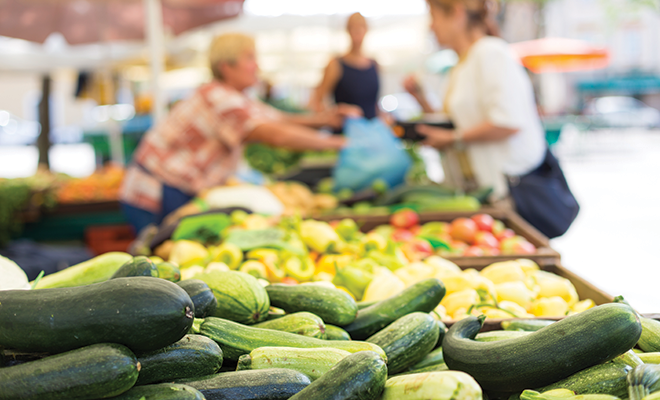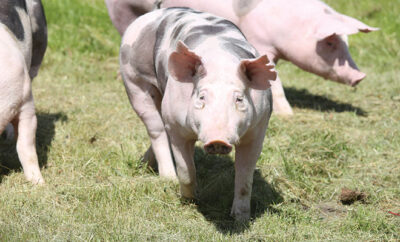
From the Garden to the Table: Supporting Local and Organic Farmers’ Markets
As summer arrives, I find myself drawn to several local farmers’ markets. The bounty of fresh fruits and vegetables changes every week as the growing season moves into full swing. Vendors at the stalls talk about the weather, their produce and whether or not they use pesticides or other chemicals. But what exactly do words like organic, natural and local mean?
“Organic” is used in a generic sense, with farmers explaining, “We don’t use any pesticides or sprays.” If you see or hear the phrase “certified organic,” it means the farmer meets specific criteria that are set by the National Organic Program. “Certified naturally grown” means the farmer meets a standard that was created specifically for farmers who sell only directly to local customers. If livestock or poultry are described as “grass fed” or “pastured,” it means they are raised for some part of their lives on pasture and may have been fed supplemental grains.
One phrase to beware of is “locally grown.” This might refer to food grown on a small family farm, a more conventional large farm, or a corporate farm. If you feel it’s important to buy direct from small farms, the claim of “locally grown” may not mean what you think.
But what is the advantage of supporting smaller, local farms? Is there any real benefit to the time and effort involved in finding organic foods? Census data tells us that the number of farms in the United States has declined in the last 50 years, from just more than 4 million to 2 million. But in that same period of time, our population grew by about 140 million people, which means that the size of farms has increased.
Production of food has had to move to large scale operations, with food processing keeping pace with that growth. Larger farms specialize in growing a single crop, using more chemicals to ensure bigger harvests. Shipping requires harvesting plants just before they ripen in order to reduce spoilage. And mass production, shipping and processing mean that more resources are dedicated to food handling, packaging and distribution.
From a nutritional standpoint, mass-produced food is measurably lower in micronutrients than food grown in a more sustainable environment. Whether it is loss of biodiversity or declining soil quality, high-yield produce is lower in iron, potassium, calcium, zinc and selenium. Large scale processing and preparation also mean an increased risk of things that we don’t want in our food. The Centers for Disease Control and Prevention tracks the number of illnesses caused by foodborne disease such as norovirus, salmonella, E. coli and staphylococcus aureus. CDC estimates based on 2018 data project that each year these and other pathogens cause more than 48 million illnesses, 128,000 hospital visits and 3,000 deaths.
In contrast, sustainable farming practices tend to minimize pesticide use and increase composting, which promotes good soil structure. Smaller local farms reduce the need for packaging, refrigeration and shipping. Organically grown plants are higher in antioxidants and vitamin C. Meats, dairy products and eggs from pastured animals have a higher content of omega-3, vitamins A and E, and a better ratio of good (HDL) versus bad (LDL) cholesterol.
Small-scale farmers must also cope with the fact that some diseases are resistant to treatment. Goats and sheep raised for cheese and meat are prone to certain parasites that have become resistant to chemical dewormers. Farmers are learning to cope by changing the crops that the animals browse and using different fertilizers to discourage growth of worms.
If these health benefits inspire you to buy directly from a smaller farm, one simple way is to get involved in a CSA program. Community Supported Agriculture programs are available locally, including participation with grocery store chains. Consumers sign up for a “share” of a farm’s harvest by paying an up-front fee; weekly bags or boxes of produce are distributed, either by delivery or at a central pickup location. Some CSAs offer more variety than others, with choices including fruit, jams, honey, meats, eggs and cheese. This way the farmers can count on a consistent cash flow, and consumers enjoy food harvested at the peak of ripeness.
One drawback to CSAs is that you are a partner in risk with the farmer, who is at the mercy of the weather. Storms, rain, hail, heat and drought may make your dreams of a bountiful harvest wither along with the crops. If you want to learn more about local farms and CSAs, check with your grocer or take time to talk with the farmers at your local markets and farm stands.
Secretary of Agriculture Tom Vilsack has said, “Local and regional food systems are about opportunity.” The folks who rise before dawn to harvest their crops for market just might give you the opportunity of a lifetime. ■
Sources: brainyquote.com, cdc.gov, foodroutes.org and localharvest.org.







